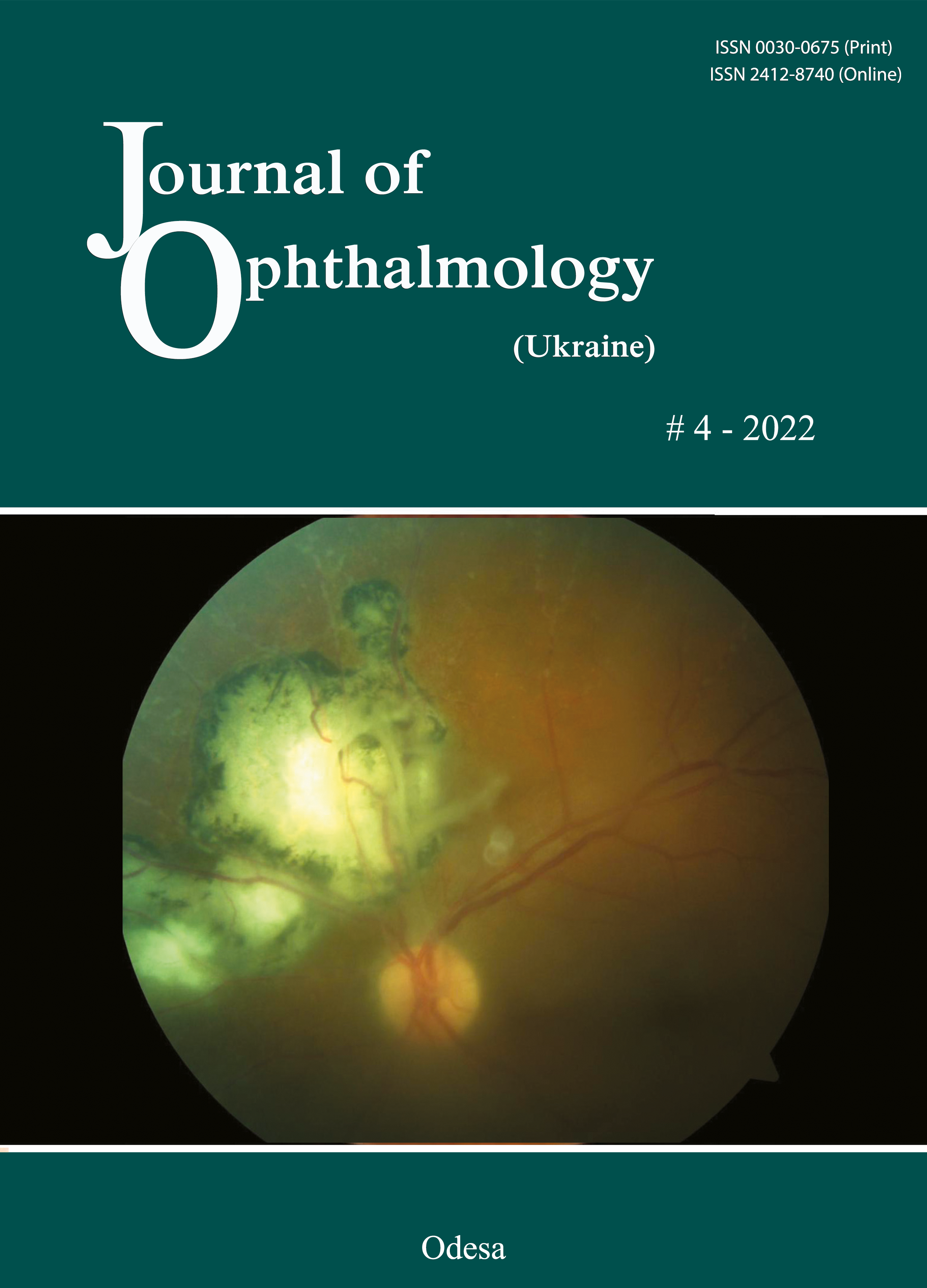High-dose intravitreal chemotherapy in the treatment of high-risk retinoblastoma
DOI:
https://doi.org/10.31288/oftalmolzh202242327Keywords:
retinoblastoma, intravitreal chemotherapy, combination chemotherapy, childrenAbstract
Background: Intravitreal chemotherapy (IVitC; intravitreal cytostatic injections) is the most promising field of multiagent chemotherapy for retinoblastoma, and, when combined with systemic multiagent chemotherapy, enables maximum effects on the tumor.
Purpose: To improve the method of primary combination multiagent chemotherapy by increasing the melphalan dose and shortening the interval between the first and last injections in IVitC for high-risk retinoblastoma.
Material and Methods: As per the improved methodology, melphalan was intravitreally injected at a dose of 20 or 30 µg in 0.1 ml, depending on the type of tumor and type of vitreous seeds, with the interval between intravitreal injections shortened to 10-11 days. The treatment method proposed was used in 8 eyes with a large high-risk tumor (7 eyes with a T3 tumor and one eye with a T2 tumor) in 7 patients aged 42 ± 4.1 months (range, 2 to 60 months).
Conclusion: We have developed a method of treatment for high-risk T3 retinoblastomas with or without vitreous seeds which involves local chemotherapy at an increased dose of 20 µg or 30 µg every 10 to 14 days, in the presence of combination multiagent chemotherapy incorporating systemic multiagent chemotherapy, chemoreduction, every three weeks. Our clinical studies demonstrated that the use of the method proposed resulted in tumor size reduction, tumor density increase and tumor calcification, with necrotic changes in vitreous seeds in eyes poorly responsive to the standard intravitreal dose of 10 µg melphalan in 0.1 ml diluent. The major indications for an increase in intravitreal melphalan dose to 20 µg are large T2 or T3 tumors located in the macular or juxtpapillary retina, with loss of tumor capsule integrity, dust vitreous seeds or cloud vitreous seeds. In addition, in the absence of parental consent for enucleation, an intravitreal melphalan dose can be increased to 30 µg as an alternative to enucleation for large T3 tumors with tumor capsule rupture, release of tumor fragments into the vitreous, spherical vitreous seeds, and blindness with no potential for vision restoration.
References
1.Bobrova NF, Sorochynska TA, Smaglii DV. [Method of combination treatment for retinoblastoma]. Patent of Ukraine UA 55690. Bulletin No.24/2010 issued on March 12, 2018. Ukrainian.
2.Bobrova NF, Sorochynska TA. [Combination (intravitreal and intravenous) multiagent chemotherapy in eye salvage treatment for retinoblastoma]. Oftalmol Zh. 2011;2: 38-44. Russian.Crossref
3.Bobrova NF, Sorochynska TA. [Efficacy of combination multiagent chemotherapy for retinoblastoma]. In: [Proceedings of the National Conference on Current Issues in Ophthalmology]. Odesa, Ivano-Frankivsk. 2019; p.9-11. Russian.
4.Seregard S, Kock B, Trampe E. Intravitreal chemotherapy for recurrent retinoblastoma in an only eye. Br J Ophthalmol. 1995 Feb;79(2):194-5. https://doi.org/10.1136/bjo.79.2.194
5.Bobrova NF, Sorochynska TA, Tronina SA, Bratishko OIu. [Method of treatment for high-risk and recurrent retinoblastoma]. Patent of Ukraine UA 101618. Bulletin No.19 issued on January 4, 2021. Ukrainian.
6.Suzuki S, Kaneko A. Vitreous injection therapy of melphalan for retinoblastoma. In: Proceedings of the 15th Biennial Meeting of the International Society of Ocular Oncology. November 15, 2011; Buenos Aires, Argentina.
7.Suzuki S, Aihara Y, Fujiwara M, et al. Intravitreal injection of melphalan for intraocular retinoblastoma. Jpn J Ophthalmol. 2015 May;59(3):164-72. https://doi.org/10.1007/s10384-015-0378-0
8.Munier FL, Gaillard MC, Balmer A, Beck-Popovic M. Intravitreal chemotherapy for vitreous seeding in retinoblastoma: Recent advances and perspectives. Saudi J Ophthalmol. 2013 Jul;27(3):147-50. https://doi.org/10.1016/j.sjopt.2013.06.003
9.Ghassemi F, Shields C. Intravitreal melphalan for refractory or recurrent vitreous seeding from retinoblastoma. Arch Ophthalmol. 2012 Oct;130(10):1268-71. https://doi.org/10.1001/archophthalmol.2012.1983
10.Shields CL, Manjandavida FP, Arepalli S, et al. Intravitreal melphalan for persistent or recurrent retinoblastoma vitreous seeds: preliminary results. JAMA Ophthalmol. 2014 Mar;132(3):319-25. https://doi.org/10.1001/jamaophthalmol.2013.7666
11.Ghassemi F, Khodabande A. Risk definition and management strategies in retinoblastoma: current perspectives. Clin Ophthalmol. 2015 Jun 8;9:985-94. https://doi.org/10.2147/OPTH.S59828
12.Bobrova NF, Sorochynska TA, Molachaniuk NI, Bratishko OIu. Ultrastructural changes in the rabbit retina after various one-time doses of intravitreal melphalan. J Ophthalmol (Ukraine). 2020; 4(495):50-5. https://doi.org/10.31288/oftalmolzh202045055
13.Bobrova NF, Sorochynska TA, Levytskyy IM. Different melphalan dozes intravitreal influence on rabbit's retina. In: [Abstract Book of Ophthalmic oncology group Meeting]. Moscow, Russia; 2015. p. 51.
14.Bobrova NF, Sorochynska TA. [Local chemotherapy for retinoblastoma]. In: [A collection of papers from East-West Ophthalmology Conference]. Ufa;2011. p.374-6. Russian.
15.Bobrova N, Sorochinskaya T. Current retinoblastoma management with intravitreal chemotherapy application. In: [Abstract Book of Joint Congress of SOE/AAO]. 2011; Geneva, Switzerland. p.146-7.
16.Bobrova NF, Sorochinskaya TA, Levytskyy IM. Intravitreal Chemotherapy - the first line of retinoblastoma eye salvage treatment. In: [Book of Abstracts of the 39th Annual Meeting of European Society]. Germany; 2013. p. 82.
Downloads
Published
How to Cite
Issue
Section
License
Copyright (c) 2025 Н. Ф. Боброва, Т. А. Сорочинська, С. А. Троніна, Т. В. Романова, О. Ю. Братішко

This work is licensed under a Creative Commons Attribution 4.0 International License.
This work is licensed under a Creative Commons Attribution 4.0 International (CC BY 4.0) that allows users to read, download, copy, distribute, print, search, or link to the full texts of the articles, or use them for any other lawful purpose, without asking prior permission from the publisher or the author as long as they cite the source.
COPYRIGHT NOTICE
Authors who publish in this journal agree to the following terms:
- Authors hold copyright immediately after publication of their works and retain publishing rights without any restrictions.
- The copyright commencement date complies the publication date of the issue, where the article is included in.
DEPOSIT POLICY
- Authors are permitted and encouraged to post their work online (e.g., in institutional repositories or on their website) during the editorial process, as it can lead to productive exchanges, as well as earlier and greater citation of published work.
- Authors are able to enter into separate, additional contractual arrangements for the non-exclusive distribution of the journal's published version of the work with an acknowledgement of its initial publication in this journal.
- Post-print (post-refereeing manuscript version) and publisher's PDF-version self-archiving is allowed.
- Archiving the pre-print (pre-refereeing manuscript version) not allowed.












